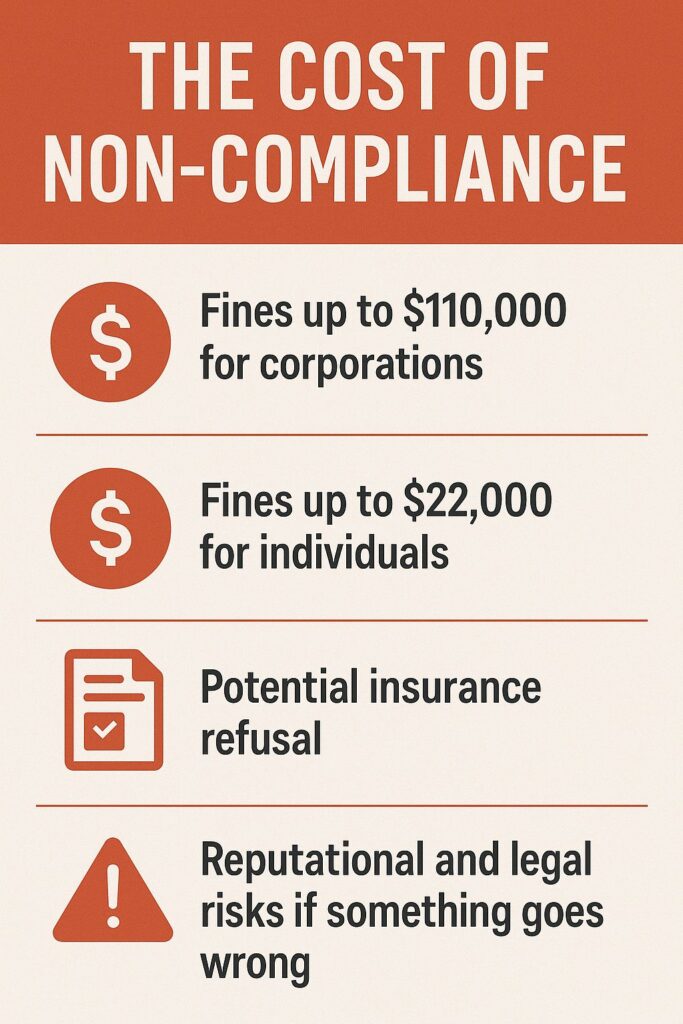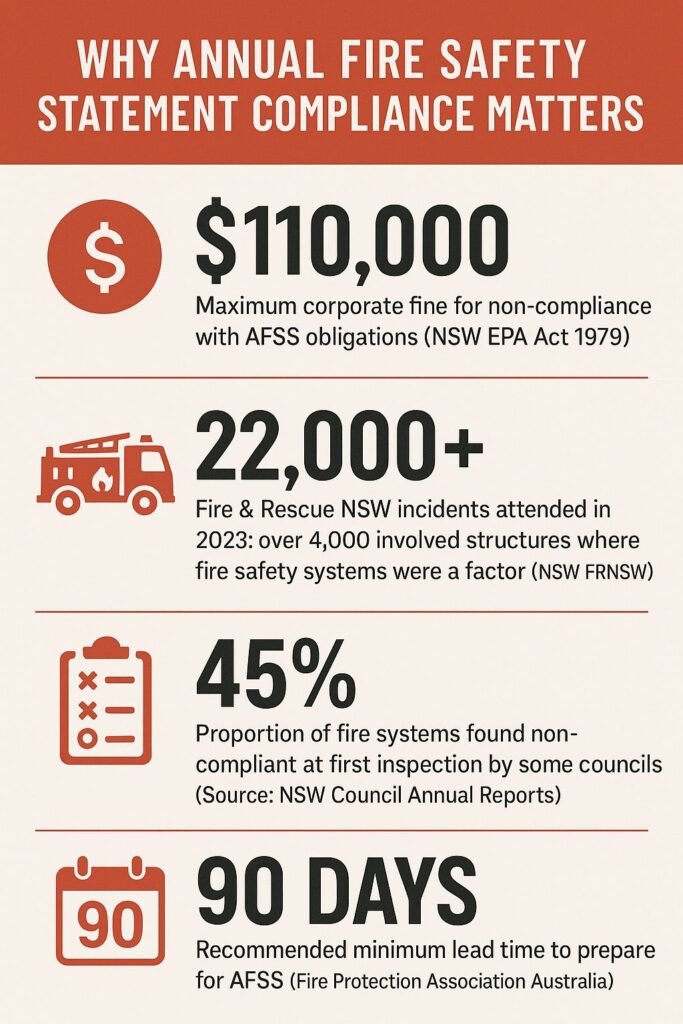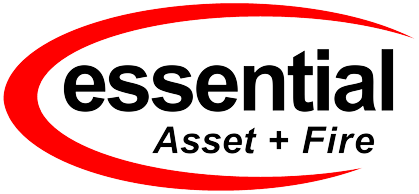Annual Fire Safety Statements & How to Avoid Costly Compliance Mistakes
Quick Summary
If you’re responsible for managing a commercial, residential, or strata property, amongst the most critical compliance tasks you face each year, is lodging your Annual Fire Safety Statement (AFSS). Done right, it’s a cornerstone of protecting your tenants, your property, and your business reputation, which this article aims to help you achieve.
Table Of Contents
For many property owners and managers, the AFSS process feels like paperwork for paperwork’s sake, but that attitude is risky. Done wrong, it can lead to hefty fines, invalidated insurance, or worse, put lives in danger. Done right, it’s a cornerstone of protecting your tenants, your property, and your business reputation.
At Essential Asset & Fire, we’ve seen the good, the bad, and the expensive when it comes to AFSS compliance. This guide is here to help you understand what’s required, where people go wrong and how to avoid common and costly mistakes.
What Is An Annual Fire Safety Statement (AFSS)?
An Annual Fire Safety Statement (AFSS) is a legally required document for most buildings in NSW. It’s your formal declaration to the local council and Fire and Rescue NSW that the essential fire safety measures (EFSMs) within your building — like hydrants, extinguishers, exit signs, alarms, and more — have been properly maintained and are capable of operating effectively in an emergency.
The Environmental Planning and Assessment Regulation 2021 governs these obligations. In simple terms:
- Engage a competent, accredited fire safety practitioner to assess your fire safety measures.
- Rectify any faults or failures identified
- Submit your signed AFSS to the council and Fire and Rescue NSW annually, on time
- Display a copy prominently in your building.
The Consequences Of Non-Compliance Can Be Serious

- Fines up to $110,000 for corporations
- Fines up to $22,000 for individuals
- Potential insurance refusal
- Reputational and legal risks if something goes wrong
More importantly, these measures are in place because fires happen. According to Fire and Rescue NSW, they respond to over 4,000 structure fires each year — and failures in fire safety systems often contribute to outcomes far worse than they need to be.
Why AFSS Compliance Will Become More Critical In 2026 & Beyond
From February 2026, all essential fire safety measures must be maintained in line with AS 1851-2012, the Australian Standard for routine servicing of fire protection systems
Councils are also under increasing pressure to ensure buildings meet standards and legislation is becoming increasingly precise. Recent reforms have made it mandatory for accredited practitioners to assess all essential fire safety measures before your AFSS is submitted. No more shortcuts, no more assumptions.
Additionally, we’re seeing insurers demand stricter proof of compliance before they’ll honour fire-related claims. If you can’t produce a current AFSS, you might find yourself out of pocket — regardless of how faithfully you’ve paid your premiums.
Consider this:
- Your AFSS is public record – councils display lists of overdue or non-compliant buildings.
- Tenants are becoming more aware – prospective tenants and buyers often ask to see AFSS documentation.
- Your insurance policy may require it – fire-related claims may be denied without it.
In short: compliance protects more than just lives, it protects your investments.
The 7 Most Common AFSS Mistakes & How to Avoid Them
Over the years at Essential Asset & Fire, we’ve noticed a pattern in the mistakes that cost property owners time, money, and stress. Here’s what to avoid.
1 – Leaving It Too Late
We’ve had more panicked calls than we can count from owners who realise their AFSS is due… next week. The reality is, these assessments take time. If faults are found, rectifications aren’t always immediate, some parts or works may require weeks to arrange.
Solution: Start your AFSS process at least three months before your due date. This allows time for inspections, reporting, repairs, and final certification.
2 – Using Non-Accredited Providers
Only a NSW-accredited practitioner (fire safety) can certify the effectiveness of your essential fire safety measures. Using a general handyman, building manager, or non-accredited contractor means your AFSS submission is invalid.
Solution: Always verify accreditation through the NSW Fair Trading Accredited Practitioner Register.
3 – Ignoring Small Defects Until It’s Too Late
A leaking hydrant booster or broken exit light may seem minor, but come AFSS time, it’s a fail. Small issues snowball into big compliance headaches if left unattended.
4 – Poor Record-Keeping
Lost paperwork leads to delays. Councils require sight of previous AFSS submissions. Insurers require maintenance logs. Poor documentation can cause fines, delays, and increased costs.
Solution: Maintain a secure, centralised digital compliance register. NSW law requires you to keep these documents readily available for council or fire inspections. At Asset & Fire, our clients enjoy online access to all records via our secure portal.
5 – Failing to Notify Changes to Fire Systems
If you modify your fire systems (even minor upgrades), these must be re-assessed before your next AFSS. Missing this step leads to non-compliance.
Solution: Notify your fire safety provider immediately of any changes. They can advise if re-certification is needed.
6 – Misunderstanding Who’s Responsible
Owners often wrongly assume their tenants, building managers, or contractors are handling AFSS compliance. Ultimately, the legal responsibility rests with the building owner.
Solution: Ensure contracts and leases are clear on responsibilities, but retain oversight yourself.
7 – Underestimating Council Scrutiny
Councils are getting tougher. Random inspections are more common and councils expect absolute accuracy in AFSS submissions.
Solution: Engage a reputable provider (like Asset & Fire) who works with council expectations in mind, not just minimum standards.
Ready To Discuss Your Requirements?
Our Experts Look Forward To Hearing From You!
The Hidden Costs of Getting AFSS Wrong
Aside from fines and legal action, non-compliance can hit your bottom line in ways owners often overlook:
| Risk | Impact |
| Invalid Insurance | Claims denied for fire-related incidents. |
| Delays in Leasing/Sale | Non-compliance delays transactions. |
| Reputational Damage | Impacts tenants’ trust and valuation. |
| Increased Costs | Rectification works under council pressure are typically more expensive. |
Why Your Annual Fire Safety Statement Isn’t Just Paperwork
It’s easy to view the AFSS as another admin task. But think about it differently, it’s your annual health check for life safety systems. The systems you rely on to protect people when things go wrong.
As tragic headlines regularly remind us, fires don’t discriminate. They don’t wait for your paperwork to catch up. Compliance ensures systems are operational when lives depend on them.
Key Statistics That Highlight Why Compliance Matters

- $110,000 – Maximum corporate fine for non-compliance with AFSS obligations (NSW EPA Act 1979)
- 22,000+ – Fire & Rescue NSW incidents attended in 2023; over 4,000 involved structures where fire safety systems were a factor (NSW FRNSW)
- 45% – Proportion of fire systems found non-compliant at first inspection by some councils (NSW Council Annual Reports)
- 90 days – Recommended minimum lead time to prepare for AFSS (Fire Protection Association Australia guidance)
Final Thoughts: Proactive Beats Reactive
Annual Fire Safety Statements shouldn’t be stressful, expensive, or last-minute. With the right approach and the right partner, compliance becomes part of your routine building management, not a source of panic.
At Essential Asset & Fire, we make it our business to ensure you’re protected, not just legally, but practically. Our goal? No nasty surprises, no last-minute panics, just reliable and proactive management of your fire safety obligations.
If you want peace of mind about your AFSS, we’re ready to help.
Frequently Asked Questions (FAQ)
A: Every 12 months, without fail. Your submission date is fixed by your original fire safety schedule.
A: Yes. A copy must be displayed prominently in the building, typically in the foyer.
A: No. Only accredited practitioners can conduct assessments and sign off your AFSS.
A: All Essential Fire Safety Measures such as hydrants, alarms, exit lighting, smoke doors, sprinklers, and hose reels.
A: Absolutely. Insurers often require current AFSS as part of risk assessment or claims processing.
GET IN TOUCH
Schedule A FREE Discovery Call
Important Disclaimer: This article is general in nature and does not constitute legal or building compliance advice. Always consult a licensed fire safety practitioner and review relevant legislation for your property classification.
References:

Request a Free Quote
Get a no-obligation quote today—fast, easy, and completely free!




